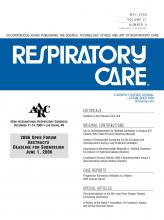Abstract
INTRODUCTION: Electrostaticattraction of aerosolized particles to the inner walls of an aerosol holding chamber (HC) made from a nonconducting material can reduce medication delivery, particularly if there is a delay between actuation and inhalation.
OBJECTIVE: Compare total emitted mass and fine-particle mass (mass of particles < 4.7 μm) of hydrofluoroalkane-propelled albuterol from similar-sized HCs manufactured from conductive material (Vortex), charge-dissipative material (AeroChamber Max), and nonconductive material (OptiChamber Advantage, ProChamber, Breathrite, PocketChamber, and ACE), with and without wash/rinse pretreatment of the HC interior with ionic detergent, and with 2-s and 5-s delays between actuation and inhalation.
METHODS: All the HCs were evaluated (1) directly from their packaging (with no wash/rinse pretreatment) and (2) after washing with ionic detergent and rinsing and drip-drying. We used an apparatus that interfaced between the HC mouthpiece and the induction port of an 8-stage Andersen cascade impactor to simulate a poorly coordinated patient, with delays of 2 s and 5 s between actuation and inhalation/sampling, at 28.3 L/min.
RESULTS: With the 2-s delay, the delivered fine-particle mass per actuation, before and after (respectively) wash/rinse pretreatment was: AeroChamber Max: 23.8 ± 4.8 μg, 21.5 ± 3.2 μg; Vortex: 16.2 ± 1.7 μg, 15.5 ± 2.0 μg; OptiChamber Advantage: 2.6 ± 1.2 μg, 6.7 ± 2.3 μg; ProChamber: 1.6 ± 0.4 μg, 5.1 ± 2.5 μg; Breathrite: 2.0 ± 0.9 μg, 3.2 ± 1.8 μg; PocketChamber: 3.4 ± 1.6 μg, 1.7 ± 1.6 μg; ACE: 4.5 ± 0.9 μg, 5.4 ± 2.9 μg. Similar trends, but greater reduction in aerosol delivery, were observed with the 5-s delay. Significantly greater fine-particle mass was delivered from HCs made from conducting or chargedissipative materials than from those made from nonconductive polymers, even after wash/rinse pretreatment (p < 0.01). The fine-particle mass was also significantly greater from the AeroChamber Max than from the Vortex, irrespective of wash/rinse pretreatment or delay interval (p < 0.01).
CONCLUSION: HCs made from electrically conductive materials emit significantly greater fineparticle mass, with either a 2-s or 5-s delay, than do HCs made from nonconducting materials, even with wash/rinse pretreatment.
Footnotes
- Correspondence: Joseph L Rau PhD RRT FAARC, 2734 Livsey Trail, Tucker GA 30084. E-mail: joerau{at}comcast.net.
- Copyright © 2006 by Daedalus Enterprises Inc.







